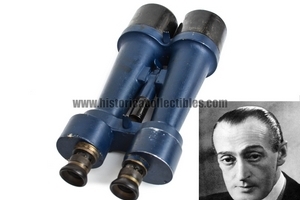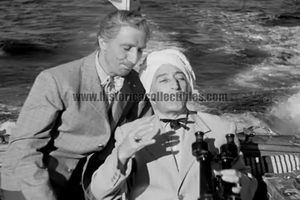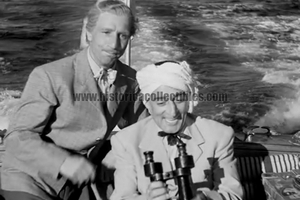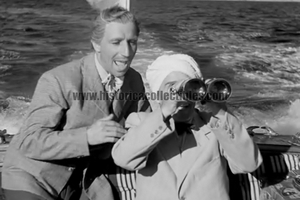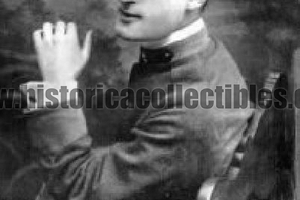Binoculars Carl Zeiss 18x60 Belonged to Antonio De Curtis (Totò), 20s
18x60 binoculars produced by Carl Zeiss in the 1920s, which belonged, for personal use, to Antonio De Curtis aka TOTÒ, who kept and used it in his private yacht "ALCOR" and which he used in the film "The Emperor of Capri" in the scene of the "crazy" motorboat before impacting the beach.
The Binoculars are accompanied by an authentication (complete with authenticated photos attached to the declaration) issued to me by Mr. Federico Clemente, son of Eduardo Clemente (Totò's 1st cousin, and his personal secretary) as legitimate heir and custodian of objects and personal effects belonging to Totò.
Originally this binoculars, like obviously all the binoculars produced by Zeiss in that period, were black in colour, following the production of the film, as declared by Mr. Federico Clemente in his certification of authenticity, it were repainted in navy blue as they were let's see today.
With this publication of mine, I want to express all my gratitude to Mr. Clemente Federico for giving me the opportunity to come into possession of an object that personally belonged to the great Totò, as well as being one of the rarest binoculars produced by Zeiss of this model.
I also extend heartfelt and affectionate thanks to Mr. Federico Clemente, who donated the entire sum obtained to charity, confirming my admiration and esteem for the gesture performed.
I came into contact with Mr. Clemente Federico, thanks to the two official websites on Totò:
www.antoniodecurtis.com
www.antoniodecurtis.org
This is the link for the binoculars: http://www.antoniodecurtis.org/news3.htm
The binoculars are in a condition of a past of great use. All mechanisms also function normally.
Totò, pseudonym of Antonio Griffo Focas Flavio Angelo Ducas Comneno Porfirogenito Gagliardi De Curtis di Bisanzio (Naples, 15 February 1898 – Rome, 15 April 1967), was an Italian actor, playwright, comedian, poet, lyricist, screenwriter and philanthropist. A symbolic actor of comedy in Italy, nicknamed "the prince of laughter", he is considered, also by virtue of some dramatic roles, one of the greatest performers in the history of Italian theater and cinema.
Born Antonio Vincenzo Stefano Clemente to Anna Clemente and Giuseppe De Curtis, in 1933 he was adopted by the Marquis Francesco Maria Gagliardi Focas of Tertiveri.
Mask in the tradition of art commedy, compared to comedians such as Buster Keaton and Charlie Chaplin, but also to the Marx brothers and Ettore Petrolini, in almost fifty years of career he ranged from theater (with over 50 titles) to cinema (with 97 films) and on television (with 9 TV series and various advertising sketches), working with many of the most famous protagonists on the Italian scene and reaching box office records with numerous of his films. He used his own interpretative uniqueness, which stood out both in purely brilliant scripts and in more involved parts, on which he oriented himself above all towards the last phase of his life, which ended in conditions of almost total blindness due to a serious form of chorioretinitis, probably aggravated by long exposure to stage lights. Often panned by most of his contemporary film critics, he was widely re-evaluated after his death, so much so that he is still today among the most popular Italian comedians of all time.
Carl Zeiss takes its name from its founder, Carl Zeiss, who on November 17, 1846 chose the small town of Jena, in Thuringia, as the location for his precision optical equipment factory. Thanks to the severe quality control that Carl Zeiss imposed on his products, going so far as to personally destroy the microscopes that did not pass the tests, the newly formed Zeiss became the official supplier of the University of Jena and received the gold medal of the industrial exhibition in 1861 of Thuringia as the best research instrument produced in Germany, awarded to the Stand I microscope of 1857.
In 1866 the thousandth microscope was produced and the name Zeiss became known throughout European scientific circles. Thanks to studies on the Porro prism, in 1893 Abbe patented double prism binoculars, which accentuated the perception of depth.
The mass production of Zeiss binoculars began in 1894, already at the beginning of the twentieth century more than 30,000 were made, at the beginning of the First World War the quota had risen to 500,000 and, at the end of the Second World War, as many as 2,260,000 were produced binoculars for the civil and military market.
Models were made starting from 4x11 mm to 12x40 mm, up to real giants such as the 80 mm and 100 mm. Thanks to studies conducted on the perception of light in low light situations, it was demonstrated that the average dilation of the pupil in an adult is approximately 7 mm.
For this reason, the 7x50 mm model was introduced in 1910 and remained on the market until 1917 with few changes to the materials used. In 1926, following the post-war crisis of the First World War with the Treaty of Versailles which bankrupted many important German companies, Zeiss purchased "C.P. GOERZ" and founded Zeiss Ikon in 1926.
In 1937 Zeiss had commercial contacts and factories in more than 29 countries around the world. From '33 Zeiss acquired interest from the Nazi regime, which balanced production towards military instruments. It successfully produced binoculars with wide-angle optics for military use, pressure-resistant optical systems for U-boats, periscope binoculars for targeting tanks. Furthermore, Zeiss cameras were mounted on the V2s for remote sensing operations of the English coasts.
On 1 November 1935, Zeiss, in the figure of Alexander Smakula, patented a process for the treatment of optical glass with extraordinary results in terms of light transmission. Remained a military secret until 1939, it was adopted on binoculars to reduce ghost images and internal reflections.
During the Second World War, there were numerous bombings against the Zeiss factories. Jena was bombed several times by the Allies starting in 1944. Stuttgart was razed to the ground, although the Contessa-Nettel factory suffered little damage. The bombing of Dresden, in addition to devastating the city, also caused considerable damage to the Zeiss Ikon headquarters.
On April 13, 1945, American military forces entered Jena, surprising themselves that the bombing had not caused any significant damage. The main planetarium was in ruins, while the factories remained operational.

